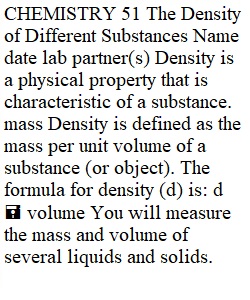


Q CHEMISTRY 51 The Density of Different Substances Name date lab partner(s) Density is a physical property that is characteristic of a substance. mass Density is defined as the mass per unit volume of a substance (or object). The formula for density (d) is: d ? volume You will measure the mass and volume of several liquids and solids. From these mass and volume measurements you can determine the densities of these liquids and solids. You will also calculate a % error value to see how close you are to the true density value(s). The percent error is given by: (exp erimental value) ? (true value) % Error ? x 100% (true value) Materials and Reagents Graduated cylinders, density liquid samples, density solid samples I. PROCEDURE (for determining the density of a liquid): (1) Record the identity of the sample (2) Record the mass of a clean dry empty graduated cylinder. (3) Record the maximum volume the graduated cylinder can measure. (4) Fill the graduated cylinder to about the half-way mark with the liquid sample. (5) Record the volume of the liquid sample. (6) Record the mass of the graduated cylinder with the liquid sample still in it. (3) Maximum volume the graduated cylinder can measure (1) Identity/Name of the liquid Sample l Sample 2 (6) Mass of graduated cylinder + mass of liquid sample (2) Mass of graduated cylinder (clean, dry & empty) Mass of liquid sample [(6) – (2)] (5) Volume of liquid sample Density of the liquid sample (D = m/v) True density of the liquid sample (google it or from book) % Error SHOW ALL CALCULATIONS (for density and % Error) II. PROCEDURE (for determining the density of a solid) (1) Record the identity of the solid sample (2) Record the mass of the solid sample. (3) Fill the 100-mL plastic graduated cylinder to about the 50-mL mark with water and record the volume of the water. (4) Tilt the graduated cylinder and carefully slide the solid sample into the cylinder. (5) Record the volume that the water and solid sample occupies in the graduated cylinder. (1) Identity/name of the solid sample Sample l Sample 2 (2) Mass of the solid sample (5) Volume of water and solid sample in graduated cylinder (3) Volume of water in graduated cylinder Volume of solid sample [(5) – (3)] Density of the solid sample (D =m/v) True density of the solid sample (google it or from book) % Error SHOW all CALCULATIONS (for density and % Error) Discussion 1. List sources of experimental error. 2. What would you do differently to improve the results of this experiment?
View Related Questions